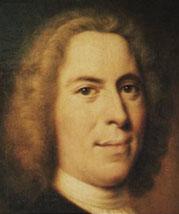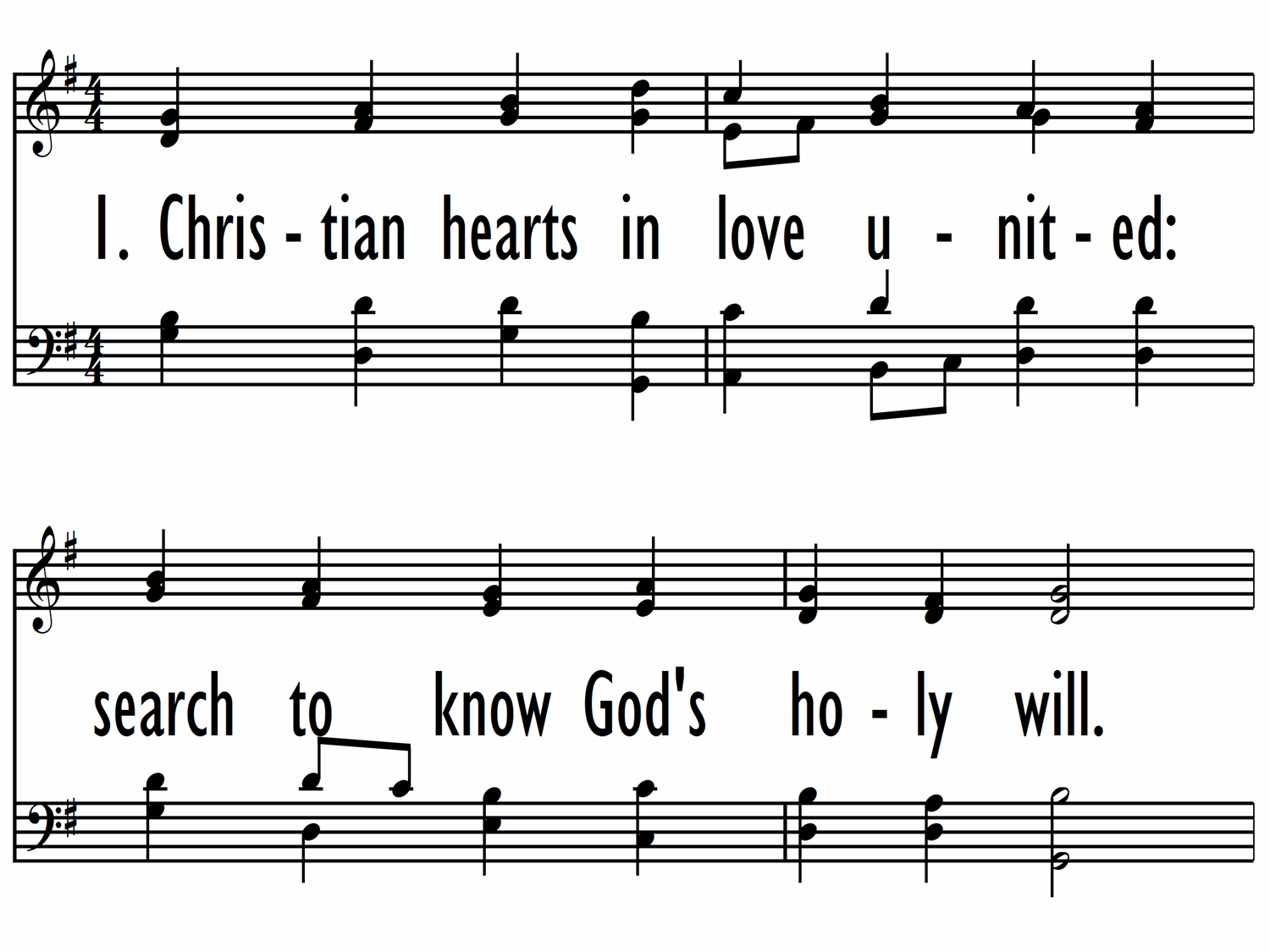- |
User Links
Christian Hearts in Love United

Christian hearts, in love united
Translator: Frederick William Foster; Author: Nicolaus Ludwig, Graf von Zinzendorf (1723)Tune: O DU LIEBE MEINER LIEBE (Thommen)
Published in 16 hymnals
Printable scores: PDF, MusicXMLPlayable presentation: Lyrics only, lyrics + musicAudio files: MIDI, Recording
Representative Text
1. Christian hearts, in love united,
Seeking rest in Jesus, find;
Has he not your love ignited
Deeply in your hearts and minds?
Members on our Head depending
Lights relfecting him, our Sun,
Servants, his commands attending,
We in him, our Lord, are one.
2. Come, then, come, O flock of Jesus,
Covenant with him anew;
Unto him who conquered for us,
Pledge we love and service true;
And should our love's union holy
Firmly linked no more remain,
Wait we at his footstool lowly,
Till he draws us close again.
3. Oh that we, his steps to follow,
Midst affliction, scorn, and spite,
And his sacred name to hallow,
Will each other more excite.
Then the souls he joined together
Will, according to his pray'r,
Be accepted of the Father,
And his kind protection share.
4. Grant, Lord, that with your direction,
"Love each other," we comply,
Aiming with unfeigned affection
Your love to exemplify;
Let our mutual love be glowing,
Thus will others plainly view,
How we, as on one stem growing,
Living branches are in you.
Translator: Frederick William Foster
Foster, Frederick William, second son. of William Foster, was born at Bradford, Aug. 1, 1760, and educated at Fulneck, near Leeds, and at Barby in Prussian Saxony. Entering the Moravian Ministry he held several appointments until 1818, when he was consecrated a Bishop of the Moravian Church. He died at Ockbrook, near Derby, April 12, 1835. He compiled the Moravian Hymn Book of 1801, the Supplement of 1808, and the revised edition of 1826. His translations from the German, and his original hymns appeared in that collection. Two of his original hymns are in the Irish Church Hymnal, 1873; (1) "Lord, Who didst sanctify" 1808 (Holiness desired); and (2) "With thanks before the Lord appear," 1826 (Praise of the Saviour). [George Arthur… Go to person page >Author: Nicolaus Ludwig, Graf von Zinzendorf
 Zinzendorf, Count Nicolaus Ludwig, the founder of the religious community of Herrnhut and the apostle of the United Brethren, was born at Dresden May 26, 1700. It is not often that noble blood and worldly wealth are allied with true piety and missionary zeal. Such, however, was the case with Count Zinzendorf. In 1731 Zinzendorf resigned all public duties and devoted himself to missionary work. He traveled extensively on the Continent, in Great Britain, and in America, preaching "Christ, and him crucified," and organizing societies of Moravian brethren. John Wesley is said to have been under obligation to Zinzendorf for some ideas on singing, organization of classes, and Church government. Zinzendorf was the author of some two thousand hymn… Go to person page >
Zinzendorf, Count Nicolaus Ludwig, the founder of the religious community of Herrnhut and the apostle of the United Brethren, was born at Dresden May 26, 1700. It is not often that noble blood and worldly wealth are allied with true piety and missionary zeal. Such, however, was the case with Count Zinzendorf. In 1731 Zinzendorf resigned all public duties and devoted himself to missionary work. He traveled extensively on the Continent, in Great Britain, and in America, preaching "Christ, and him crucified," and organizing societies of Moravian brethren. John Wesley is said to have been under obligation to Zinzendorf for some ideas on singing, organization of classes, and Church government. Zinzendorf was the author of some two thousand hymn… Go to person page >Text Information
| First Line: | Christian hearts, in love united |
| Title: | Christian Hearts in Love United |
| Author: | Nicolaus Ludwig, Graf von Zinzendorf (1723) |
| Translator: | Frederick William Foster |
| Meter: | 8.7.8.7 D |
| Language: | English |
| Copyright: | Public Domain |
Notes
Scripture References:
st. 1 = Eph. 4:15-16
st. 2 = John 13:34, John 15:5
In 1723 Count Nicolaus L. von Zinzendorf (b. Dresden, Germany, 1700; d. Herrnhut, Germany, 1760) wrote an extended poem, "Die letzten Reden unsers Herrn," of 320 stanzas on the teachings of Jesus found in John 14-17. A hymn text beginning "Herz und Herz vereint zusammen" was taken from this work and published in various early Moravian hymnals.
Zinzendorfs career, achievements, and influence were of great import, both in his own community and worldwide. Although his family insisted that he be trained in law, his inclination was always toward religious matters. A devout youth who was influence by Philipp Spener and the Pietists, he wrote his first hymn at the age of twelve. After his graduation from Wittenberg University in 1719, he became the official poet for the Saxon court.
His life took focus in 1722 when a small group of persecuted Bohemian Brethren, or Moravians (spiritual descendants of John Hus), sought a place of refuge. Zinzendorf granted them protection on his estate in Bertelsdorf; they called their new home "Herrnhut," or "the Lord's shelter." The settlement grew to over two hundred homes and became an outstanding Christian community of piety, worship, and mission. Some of these missionaries influenced John and Charles Wesley (PHH 267). Zinzendorf became their bishop in 1737 but then was banished for a decade from Saxony by Saxon officials because of his evangelical convictions; he returned to Herrnhut in 1748. During his banishment he traveled throughout Europe, to St. Petersburg in Russia, and to the United States and the West Indies in order to establish and encourage Moravian mission centers.
He promoted the tradition of congregational singing at Herrnhut and elsewhere and frequently led long hymn sings in an improvised medley format, which included hymn fragments or choruses. Some two thousand hymn texts are attributed to him, but many are judged to be too subjective for congregational use today. Das Gesang-Buch der Gemeine Herrnhut (1735), with its almost one thousand texts, was compiled under his supervision and contained some two hundred of his own hymns. He also produced a two-volume hymnal in London, Alt- und Neuer Bruder-Gesang (1753-1754), which contained over three thousand German hymn texts grouped in chronological order.
The three stanzas in the Psalter Hymnal come from a composite translation that depends on English versions by Frederick W. Foster and John Miller (Johannes Muller) in the Moravian Hymn Book (1789, with revisions in the 1886 ed.) and by Walter Klaassen in The Mennonite Hymnal (1969). This text gained great significance at the Herrnhut settlement, where it was often used after the healing of internal conflict.
This distinguished text about the church's "communion of saints" proclaims that Christians live in union with Christ (st. 1), love each other (st. 2), and serve and witness in the world (st. 3).
Liturgical Use:
Regular Sunday worship services; times of renewal and reconciliation; profession of faith; ecumenical services and church conventions; church festivals.
--Psalter Hymnal Handbook, 1988
Tune
O DU LIEBE MEINER LIEBE (Thommen)Originally a folk song ("Sollen nun die grünen Jahre") dating from around 1700, O DU LIEBE MEINER LIEBE was used as a hymn tune in the Catholic hymnal Bambergisches Gesangbuch (1732). The tune name is the incipit of the text to which it was set in Johann Thommen's Erbaulicher Musicalischer Christen…
Timeline
Arrangements
Media
- MIDI file from Baptist Hymnal 1991 #378
- MIDI file from The Cyber Hymnal #816
- Audio recording from Lift Up Your Hearts: psalms, hymns, and spiritual songs #727
- Audio recording from Lift Up Your Hearts: psalms, hymns, and spiritual songs #727
- Audio recording from Lift Up Your Hearts: psalms, hymns, and spiritual songs #727
- Audio recording from Lift Up Your Hearts: psalms, hymns, and spiritual songs #727
- Audio recording from Lift Up Your Hearts: psalms, hymns, and spiritual songs #727
- Audio recording from Lift Up Your Hearts: psalms, hymns, and spiritual songs #727
- MIDI file from Psalter Hymnal (Gray) #513
- MIDI file from Psalter Hymnal (Gray) #513


 My Starred Hymns
My Starred Hymns




